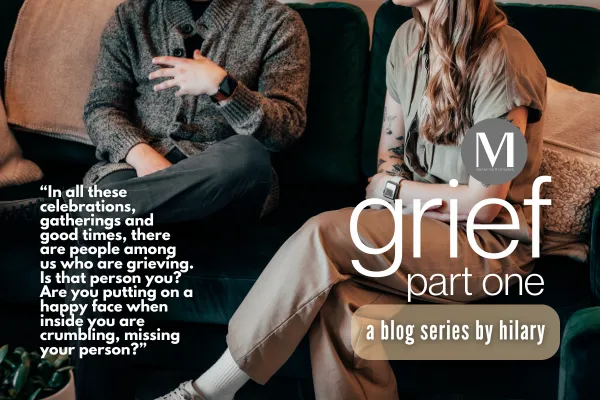the blog
A place for our team to share about topics they are passionate about, in hopes of allowing you to see and understand a bit more behind the faces on these pages.

Grief: Part One
In Canada, we are in the middle of a steady stream of holidays and gatherings that are seasoned with love and joy. The moment we closed our doors on Hallowe’en some of you started putting up your Christmas tree. As the last firework of Diwali faded from sight, perhaps you relished in the joy of being together. Maybe you are waiting excitedly for the right moment to pull out your treasured menorah. In all these celebrations, gatherings and good times, there are people among us who are grieving. Is that person you? Are you putting on a happy face when inside you are crumbling, missing your person?
As you approach this season, your grief might hang in the air like the scent of cinnamon or stand audaciously in the hallway of your holiday spirit, but it’s there. Over the next few weeks, we are going to explore grief and the holidays. First, we will reframe some of the widespread thinking about grief and define what grief is and how it can look. In part two, we will discuss leaning into grief and how to navigate this new life as the griever. In part three, those of you who are supporting grievers will be given helpful tips on how to show up for the people in your life who are grieving.
Let’s start by clarifying terms we use or hear when it comes to grief. Grief is the personal experience of loss and refers to the internal thoughts, feelings, behaviours and physiological changes that occur in a person (Wolfelt 2018 and Worden 2010). Mourning is what happens on the outside or the process that one goes through externally as they experience grief (Worden 2010). You can also think of mourning as grief on display. Grief and mourning occur with any loss. For the purposes of the next few weeks, we will focus on death loss of a person.
North America is considered a grief illiterate society and in our broad culture we do not talk or teach about grief, death or dying. If you are feeling like no one understands what you are experiencing and no one knows what to say, you are correct. When there is a loss experienced, there can sometimes be an initial outpouring of support and space made, but grief is not contained to the 3 bereavement days many of our workplaces offer. There is no timeline or time limit. There are also many death losses that are not acknowledged at all.
Some common feelings that people experience in grief are sadness, that may come with an outward behaviour of crying, or it may not. You may also feel anger, guilt and/or loneliness. Shock or disbelief that the person is gone is expressed by many grievers. Feeling irritable for “no reason” can be another way that you are experiencing grief.
Physical symptoms for the griever can include an increased heart rate or feeling like it is hard to breathe or your breathing quickens when you think of your person. This is normal and common. A lack of energy often accompanies a griever. Even dry lips and mouth can be a physiological response in grief (Worden 2010).
Two other areas where you may experience changes are in your cognition and behaviour. Grievers often struggle to sleep or alternatively feel like they want to sleep all the time. You may experience brain fog and have trouble focusing on a task. This is extremely difficult in the early days after losing your person because there are many decisions that need to be made. You might find that you are easily confused and your mind “just isn’t working.” Often our eating is disrupted by grief and loss.
This is not an exhaustive list of what it is like to experience grief, but it is a start. It is also a place for you to be seen and to feel known that grief affects you as a whole person as much as it affects your emotional centre. Grief is not a simple feeling of sadness that passes with time. Grief is woven into physical, emotional, physiological and behavioural areas of our lives. Being able to recognize this and being aware of how we experience grief, allows us to learn how to move with it in our lives.
During the holidays, some of your grief symptoms may become more intense or you may notice them for the first time. If your sleeping is unsettled the day after you put up the Christmas lights, is it because there is a core memory connected to your loved one who died? How is your grief showing up? There is no direct path in our grief, there is no timeline or time limit. An important step in managing our grief is acknowledging that it exists. Recognizing the ways that it can show up is helpful so we can name it and nurture it. Are you feeling irritated by the traditions that are falling flat without your person? You can bravely create new traditions in their honour. You can also decline participation this year in a tradition that you are struggling with. Acknowledging your grief and then adjusting to it is a show of beautiful self-compassion.
Holding space for you until next time,
Hilary
References
Wolfelt, Alan. 2018. When Grief Is Complicated: A Model for Therapists to Understand, Identify, and Companion Grievers Lost in the Wilderness of Complicated Grief. Companioning Series. Fort Collins, CO: Companion Press.
Worden, J William. 2010. Grief Counselling and Grief Therapy: A Handbook for the Mental Health Practitioner. 4th ed. London: Routledge.
Office Location: 1200 Brock Street South, Whitby, ON. L1N 4L9
© Marquis Counselling & Consulting | ALL RIGHTS RESERVED | TERMS & CONDITIONS | PRIVACY POLICY
